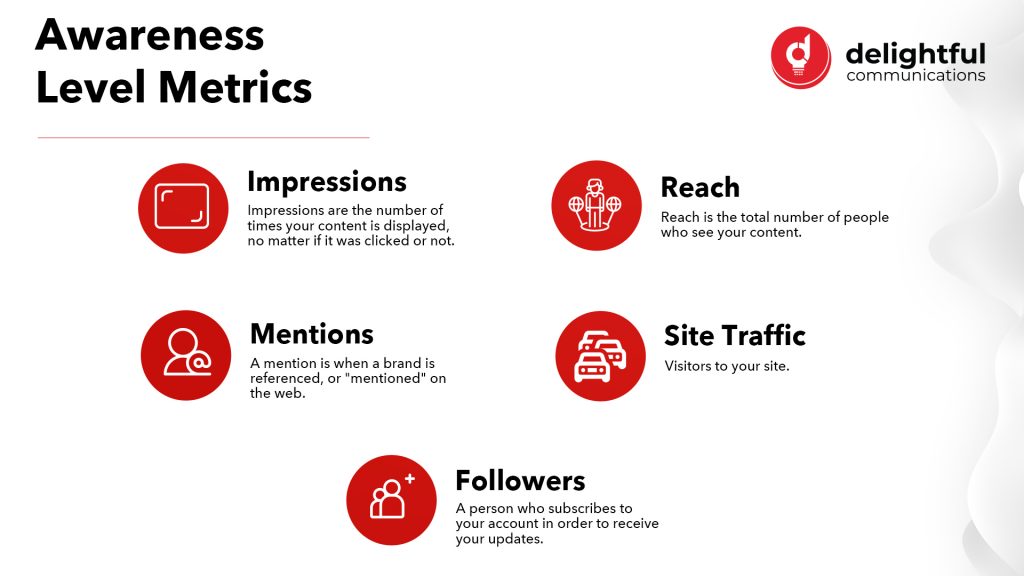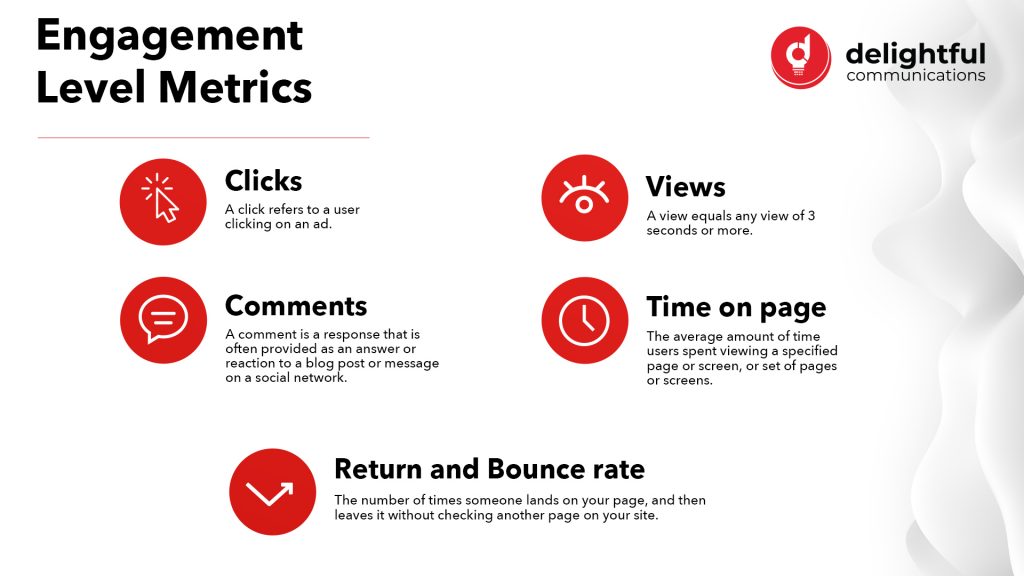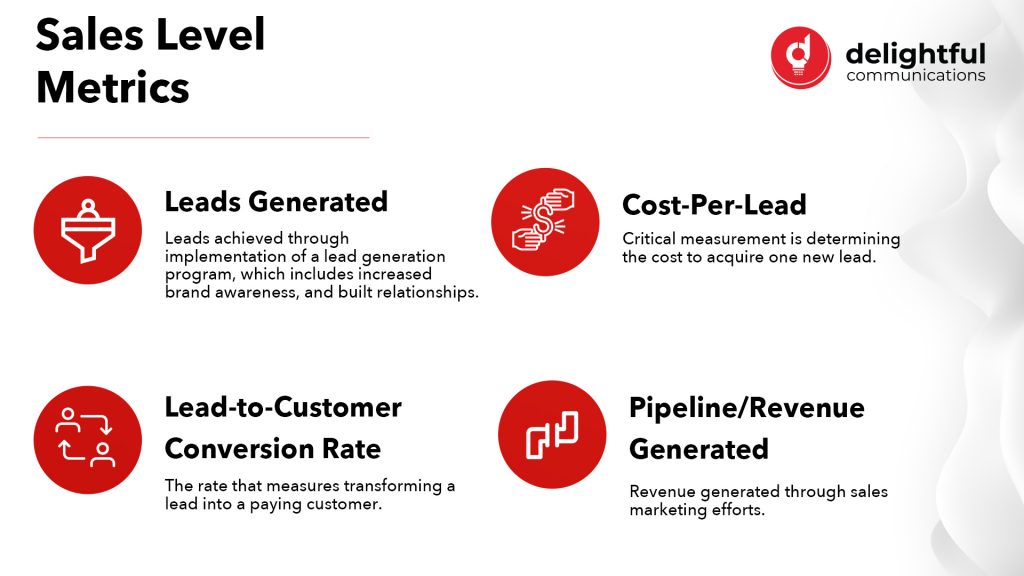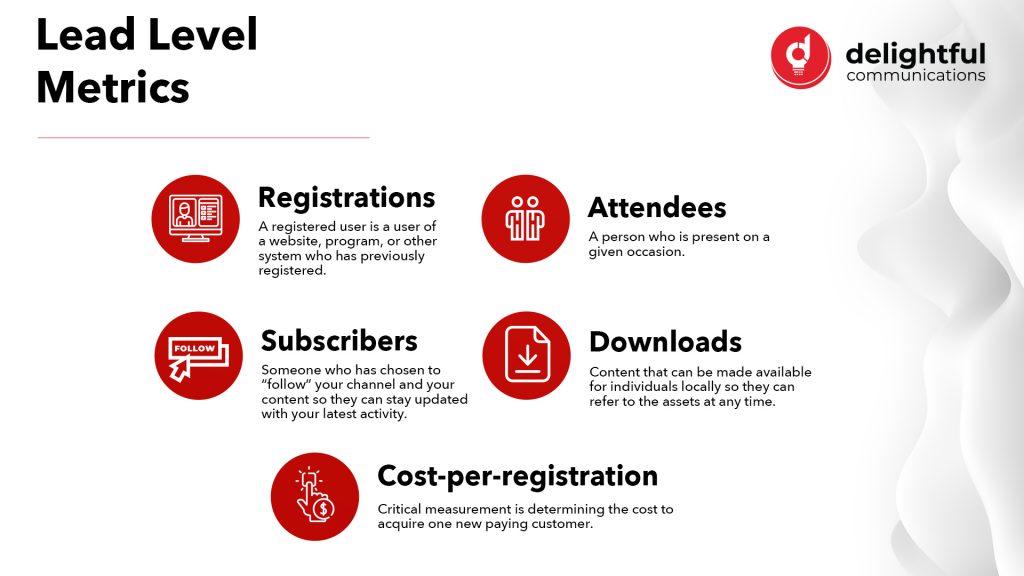
What’s a story without an outcome? What if Cinderella ended when she ran out at the stroke of midnight? Or Jack never climbed the beanstalk?
In today’s world of thought leadership and storytelling—where we focus on landing impactful narratives and building consistent brands—we are telling an incomplete story for our business if we don’t tie it to purposeful marketing metrics.
Yes, it’s amazing if we create and deliver a truly impactful brand campaign with a story that moves people to act. But if we can’t show this effort impacted the business in a meaningful way: did it even happen?
And how will you get leadership buy-in and budget for the next big idea if you’re unable to demonstrate business value now?
Tying metrics to the campaign objective and buyer journey
When launching a marketing campaign, you often have a primary goal in mind. Perhaps you want to debut a webinar series that educates on the benefits of a specific product. Or use a white paper to establish leadership and share of voice on a specific topic.
While this may be the reason why a campaign is taking place, you still need to determine how you will measure and define success. Often the hardest thing to do is to be able to point to a campaign and objectively, tangibly say: “Yes, this was a success. And here are the results to prove it.”

Step 1: Define the desired action
So how do you tie an objective to a metric? Start by analyzing why you’re doing something. If you’re launching a webinar series, you clearly want people to attend. Or if publishing a white paper, you want people to read it.
Step 2: Map out the ideal buyer journey
But don’t stop there—take it a step further and continue applying this exercise along the buyer journey. If someone attends a webinar, what would be the ideal next step? Let’s say for this scenario, it would be to request a product demo or free trial, and ultimately, buy the product.

Step 3: Start with the ultimate KPI and work backward
From there, it’s often easiest to work backward. Start by defining how many sales would make this marketing campaign (and the budget that goes along with it) worth it for the business. What number would demonstrate true business impact, or ROI?
While it’s important to have a goal to aim for, also make sure it’s a realistic one that’s supported by data. In this case, let’s say ten sales driven by this campaign would demonstrate ROI. From there, use what data you have on hand and work back to the initial desired action defined in step one: webinar attendees. For example, how many registrations tend to convert to attendees to products demos/trials to sales? If you don’t have historical data for your specific audience to rely on, then try to leverage industry averages for these calculations.
Finally, make sure to associate a timeframe with your goal based on the typical sales cycle. If it typically takes a lead three months to become a customer, then plan to truly measure the campaign’s performance based on where you are at three months after the campaign ends.

Step 4: Look at the marketing budget before committing to a goal
While it’s great being able to say a certain number of webinar registrations should help influence your sales goal, it doesn’t matter if you don’t have the budget or resources to support it. One of the first steps to look at is how much budget you have and then divide it by your registration goal. This gives you your target cost-per-registration (CPR).
From there you will need to analyze the channels at your disposal and their ability to drive the necessary volume within that budget and target CPR. While it’s not an exact science, it does give you a bit of a guidepost for determining what channels do and don’t make sense to support a campaign so you can still meet your set goal.
Telling the right metric-driven story in a data-saturated world
Once you get past the strategy phase and into execution, there’s even more data coming in and from a mix of different channels. If part of your marketing campaign consisted of email sends, then you’re dealing with bounce rates, opens, clicks, clickthrough rates, and more. For social campaigns, you have impressions, engagement, and clicks. Looking at the landing page, there is the traffic source, time on page, and bounce rate.
Needless to say, there can be staggering amounts of data coming in from one campaign. The key is to know how to shift through the noise and prioritize the marketing metrics that help create the clearest story.
Reading between the lines with metric-driven insights
While the sales and lead metrics you lined out at the beginning of the campaign are essential to track for telling the business story, you can’t ignore the other metrics. They also tell a story of their own that can help you refine and optimize your campaign as you move forward. The key is knowing which marketing metrics matter when and how to read them.
For instance, perhaps you have a Twitter ad with a high rate of people clicking on it to go to the landing page (clickthrough rate), but you notice that there is a high drop off among people landing on the page (bounce rate) and filling out the registration form.
These numbers tell a story. A tale of two roads: One of a Twitter ad that connects with your audience and evokes action. The other of a landing page that diverges from this path and instead sees an audience turn away. And the insights this brings you can be just as valuable as the final campaign results.
Perhaps it indicates you’re targeting the wrong people, and while they resonate with the creative asset and messaging, they realize this content or product is not for them once they get on the page. This means you might need to challenge assumptions about the job roles or interests that comprise your target audience. Or it could mean that, while you’re reaching the right audience, the landing page is not telling the right story. In which case, you might need to rethink how you position your messaging and unique value propositions for this audience.

Communicating campaign value to leadership
Like with any good story, your campaign report should have a clear framework: a beginning, middle, and end. And throughout it all, remember that every good story has a hero (the customer), a villain (their challenges), and an ally, or in some cases, a fairy godmother (your business/product).
And most importantly your story should be clear, straightforward, and succinct.
The beginning: Lay the groundwork for business value
Set the stage from a lens that will resonate with leadership. This often means starting with a quick synopsis of the business goals and objectives this campaign supported. If it makes sense, reference the factors driving the need for this campaign—from both a business and customer challenge perspective.
The middle: Share the primary results
This is where you get to what leadership most cares about: what results did this campaign drive for the business? Pick the two to three primary metrics that align with the business goals and objectives shared above. However, it’s not enough to just share a number. You need to help interpret this number as either a good, bad, or merely average result. You can accomplish this by including the original goals set, as well as industry or past campaign benchmarks.
The end: Offer insights and takeaways
While you don’t want to share all the data and learnings you gathered throughout the course of the campaign, focus on including takeaways that would benefit other teams or the broader business. These could be the results from image A/B testing, your most successful messaging, or a new demand gen channel that had a higher conversion rate than average.
Finally, don’t forget to include your next steps. Whether you plan to run another campaign, update messaging across a broader portion of the business to align to new findings, or further nurture leads—the end of a campaign is not the end of the story, at least not for your customers.
Plan your next marketing campaign
As you embark on your next marketing campaign, the good news is that you don’t need to go it alone or be an expert in everything. Here at Delightful Communications, we pride ourselves on our ability to offer strategic planning, creative ideation, and compelling content that captivates audiences for our clients and helps achieve business goals.
Explore our full range of services, which include strategy development, measurement and analysis, marketing demand generation, and more. Contact us for more information.
Melissa Peebles – Senior Digital Marketing Strategist
